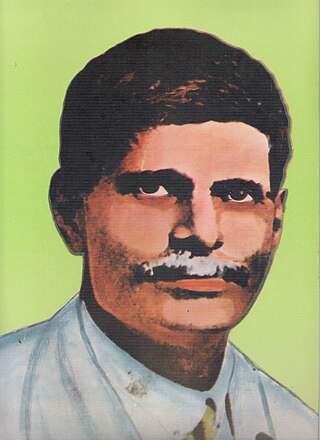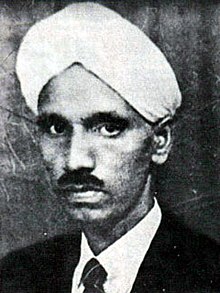
Akkineni Laxmi Vara Prasada Rao, known professionally as L. V. Prasad, was an Indian film director, producer, actor, and businessman. He was one of the pioneers of Indian cinema and is the recipient of the Dadasaheb Phalke Award, the highest Award for films in India. In 1980, he was awarded the Raghupathi Venkaiah Award, for his contribution to Telugu cinema.

Modern Theaters Ltd was an Indian film studio in Salem, Tamil Nadu started by T. R. Sundaram Mudaliar in 1935. The studio produced over more than 150 films until 1982 in Tamil, Telugu, Kannada, Malayalam, Hindi, Sinhalese and even English of which Tamil were the majority.

Raghupathi Venkaiah Naidu was an Indian filmmaker and entrepreneur widely regarded as the father of Telugu cinema. A pioneer of Indian cinema, Naidu established the first Indian-owned movie theatres in South India and founded Star of the East Films, the first film production company established by a Telugu person. He is credited with producing Bhishma Pratigna (1921), considered the first Telugu feature film, thus laying the foundation for the Telugu film industry.

Tamil cinema is the segment of Indian cinema dedicated to the production of motion pictures in the Tamil language, the main spoken language in the state of Tamil Nadu. It is nicknamed Kollywood, a portmanteau of the names Kodambakkam, a neighbourhood in Chennai, and Hollywood.

Nartanasala is a 1963 Indian Telugu-language Hindu mythological film directed by Kamalakara Kameswara Rao and written by Samudrala Sr. It stars N. T. Rama Rao, Savitri, S. V. Ranga Rao, and Relangi while Mukkamala, Mikkilineni and Dandamudi Rajagopal play supporting roles among others. Susarla Dakshinamurthi composed the film's soundtrack and background score. M. A. Rahman and S. P. S. Veerappa served as the cinematographer and editor respectively. T. V. S. Sarma was the film's art director. The film was produced by actress C. Lakshmi Rajyam and her husband C. Sridhar Rao under the Rajyam Pictures banner.

Lava Kusa is a 1963 Indian Hindu mythological film directed by C. Pullayya and C. S. Rao. Produced by Lalita Sivajyothi Films, the film is a remake of the 1934 production of the same name, which was also directed by C. Pullayya. The story is based on the Uttara Kanda of the Ramayana, focusing on Lava and Kusa, the twin sons of Rama and Sita. The cast includes N. T. Rama Rao as Rama, Anjali Devi as Sita, with Chittoor Nagayya, Kantha Rao, Sobhan Babu, S. Varalakshmi, and Kaikala Satyanarayana in supporting roles. The soundtrack features 27 songs, with the musical score primarily composed by Ghantasala.

Central Studios was an Indian film studio in the neighbourhood of Singanallur, Coimbatore in Tamil Nadu, started by B.Rangaswamy Naidu and other prominent industrialists like Swamikannu Vincent of Coimbatore in 1935 to make Tamil and other South Indian language movies. The studio was a major hub of Tamil movie production and notable for its association with many early day Tamil Movie Superstars, directors and script writers etc. and many making their career debuts here. The studio is best remembered for movies like Sivakavi, Velaikari and Haridas.

Yaragudipati Varada Rao was an Indian director, actor, screenwriter, and editor known for his works primarily in Telugu, Kannada, and Tamil films. Rao plunged into theatre and did a few stage plays before moving to Kolhapur and Bombay to act in silent films. Rao started his career as a lead actor in many silent films such as Gajendra Moksham (1923), Garuda Garvabhangam (1929), and Rose of Rajasthan (1931). Regarded as one of the greatest filmmaking pioneers of the Cinema of South India, he made motion-pictures across Telugu, Kannada, Tamil, Konkani, and Hindi languages, apart from silent films.
Thuluva Vellalar, also known as Agamudaya Mudaliar or Arcot Mudaliars, is a caste found in northern Tamil Nadu, southern Andhra Pradesh and southern Karnataka. They were an elite and dominant land-owning community.

Chittajallu Pullayya was an Indian film director and screenwriter. He is one of the earliest film personalities in Telugu cinema being associated with the industry right from the silent era.
Keechaka Vadham is an Indian silent film produced, directed, filmed and edited by R. Nataraja Mudaliar. The first film to have been made in South India, it was shot in five weeks at Nataraja Mudaliar's production house, India Film Company. As the members of the cast were Tamils, Keechaka Vadham is considered to be the first Tamil film. No print of it is known to have survived, making it a lost film.

Cinema of South India, refers to the cinema of the four major film industries in South India; primarily engaged in making feature films in the four major languages of the region, namely — Telugu, Tamil, Malayalam and Kannada. They are often colloquially referred to as Tollywood, Kollywood,Mollywood and Sandalwood, respectively.

Samikannu Vincent was a filmmaker and cinema exhibitor from Coimbatore, India. He was a pioneer in the movie business in South India. In 1905, he established tent cinemas where movies were projected in a makeshift tent in open spaces which were a precursor to modern day movie theaters. In 1914, he established Variety Hall in Coimbatore, which was one of the first permanent movie theatres in South India. He was later involved in the production and direction of Tamil movies.
Draupadi is a 1931 sound film from Indian cinema. The film was a big-budget mythological production from Ardeshir Irani's Imperial Film Company following their release of the first talkie in India, Alam Ara (1931). It was directed by Bhagwati Prasad Mishra, who had made a name for himself as a photographer and painter and had worked with Irani in his Star, Majestic, Royal and Imperial Studios. The story adaptation from Vyasa's Mahabharata and the screenplay, were by Mishra. The star cast included Prithviraj Kapoor who played the role of Karna, with Sudhabala as Draupadi, and Khalil as Krishna. The rest of cast included Hadi, Elizer, Rustom Irani and Jilloobai. The cinematographer was Adi Irani.

Jai Lava Kusa is a 2017 Indian Telugu-language action drama film written and directed by K. S. Ravindra and produced by Nandamuri Kalyan Ram under his banner N. T. R. Arts. The film stars Jr. N.T.R. in a triple role as Jai, Lava and Kusa, alongside Raashi Khanna and Nivetha Thomas. The film also features Ronit Roy, Posani Krishna Murali, Pradeep Rawat, Pavitra Lokesh, Sai Kumar, Nassar, Hamsa Nandini, Abhimanyu Singh and Harish Uthaman in the supporting roles.
Raghupathi Surya Prakash Rao Naidu (1901–1956), popularly known as R. S. Prakash, was an Indian film director, producer, and cinematographer. He was one of the pioneers of Indian cinema. He was the first director of Telugu cinema. He shot, developed and edited all his early films.
Lava Kusa is a 1934 Telugu-language Hindu mythological film directed by C. Pullayya and produced by Motilal Chamaria under the East India Film Company. The film is based on the play Lava Kusa, written by K. Subrahmanya Sastry, and marks an important milestone in early Telugu cinema. It was one of the first films to feature recorded songs, following the trend set by Sati Savitri (1933). All the songs in Lava Kusa were well received, contributing to its success.











